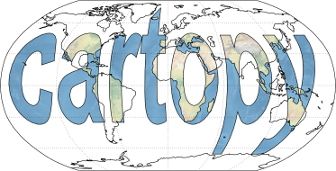Cartopy developer interfaces¶
Cartopy exposes several interfaces to help make it easier to add new functionality quickly and easily.
Data/Download API¶
In order to keep the size of a cartopy release low, the majority of data is
not included as standard. This means that, when developing new features, it is
often necessary to provide interfaces which can acquire data from external
sources (normally via HTTP). The Downloader class
has been designed to make this process as easy as possible for developers to
extend, whilst still making it possible for users to configure in their own
way.
-
class
cartopy.io.Downloader(url_template, target_path_template, pre_downloaded_path_template='')[source]¶ Represents a resource, that can be configured easily, which knows how to acquire itself (perhaps via HTTP).
The key interface method is
path()- typically all external calls will be made to that method. To get hold of an appropriateDownloaderinstance theDownloader.from_config()static method should be considered.Args:
url_template- The template of the full URL representing this- resource.
target_path_template- The template of the full path to the file- that this Downloader represents. Typically
the path will be a subdirectory of
config['data_dir'], but this is not a strict requirement. If the file does not exist when callingDownloader.path()it will be downloaded to this location.
Kwargs:
pre_downloaded_path_template- The template of a full path of a- file which has been downloaded
outside of this Downloader which
should be used as the file that
this resource represents. If the
file does not exist when
Downloader.path()is called it will not be downloaded to this location (unlike thetarget_path_templateargument).
-
FORMAT_KEYS= ('config',)¶ The minimum keys which should be provided in the
format_dictargument for thepath,url,target_path,pre_downloaded_pathandacquire_resourcemethods.
-
acquire_resource(target_path, format_dict)[source]¶ Downloads, via HTTP, the file that this resource represents. Subclasses will typically override this method.
Args:
format_dict- The dictionary which is used to replace- certain template variables. Subclasses should
document which keys are expected as a minimum
in their
FORMAT_KEYSclass attribute.
-
static
from_config(specification, config_dict=None)[source]¶ The
from_configstatic method implements the logic for acquiring a Downloader (sub)class instance from the config dictionary.Args:
specification- should be iterable, as it will be traversed- in reverse order to find the most appropriate
Downloader instance for this specification.
An example specification is
('shapefiles', 'natural_earth')for the Natural Earth shapefiles.
Kwargs:
config_dict- typically this is left as None to use the- default
cartopy.config“downloaders” dictionary.
Example:
>>> from cartopy.io import Downloader >>> >>> dnldr = Downloader('https://example.com/{name}', './{name}.txt') >>> config = {('level_1', 'level_2'): dnldr} >>> d1 = Downloader.from_config(('level_1', 'level_2', 'level_3'), ... config_dict=config) >>> print(d1.url_template) https://example.com/{name} >>> print(d1.url({'name': 'item_name'})) https://example.com/item_name
-
path(format_dict)[source]¶ Returns the path to a file on disk that this resource represents.
If the file doesn’t exist in
pre_downloaded_path()then it will check whether it exists intarget_path(), otherwise the resource will be downloaded viaacquire_resouce()fromurl()totarget_path().Typically, this is the method that most applications will call, allowing implementors of new Downloaders to specialise
acquire_resource().Args:
format_dict- The dictionary which is used to replace- certain template variables. Subclasses should
document which keys are expected as a minimum
in their
FORMAT_KEYSclass attribute.
-
pre_downloaded_path(format_dict)[source]¶ The path on disk of the file that this resource represents, if it does not exist, then no further action will be taken with this path, and all further processing will be done using
target_path()instead.Args:
format_dict- The dictionary which is used to replace- certain template variables. Subclasses should
document which keys are expected as a minimum
in their
FORMAT_KEYSclass attribute.
-
target_path(format_dict)[source]¶ The path on disk of the file that this resource represents, must either exist, or be writable by the current user. This method does not check either of these conditions.
Args:
format_dict- The dictionary which is used to replace- certain template variables. Subclasses should
document which keys are expected as a minimum
in their
FORMAT_KEYSclass attribute.
An example of specialising this class can be found in
cartopy.io.shapereader.NEShpDownloader which enables the downloading of
zipped shapefiles from the http://www.naturalearthdata.com website. All
known subclasses of Downloader are listed below for
reference:
cartopy.io.shapereader.NEShpDownloadercartopy.io.srtm.SRTMDownloader
Raster images¶
The abstraction between retrieval and visualisation of raster data means
that the cartopy.io.RasterSource class exists to retrieve an image
(given sufficient context of projection, extent, resolution etc.) while in the
matplotlib interface the
cartopy.mpl.slippy_image_artist.SlippyImageArtist
class feeds the appropriate information to the
RasterSource and visualises it on a map.
The orchestration in matplotlib is made more convenient
to the user of a GeoAxes through the
add_raster method. Anything which exposes
the validate_projection and fetch_raster methods in the form described
in RasterSource can be used as a slippy maps source in
this way.
-
class
cartopy.io.RasterSource[source]¶ Defines the cartopy raster fetching interface.
A
RasterSourceinstance is able to supply images and associated extents (as a sequence ofLocatedImageinstances) through itsfetch_raster()method.As a result, further interfacing classes, such as
cartopy.mpl.slippy_image_artist.SlippyImageArtist, can then make use of the interface for functionality such as interactive image retrieval with pan and zoom functionality.-
fetch_raster(projection, extent, target_resolution)[source]¶ Return a sequence of images with extents given some constraining information.
- projection :
cartopy.crs.Projection - The desired projection of the image.
- extent : iterable of length 4
- The extent of the requested image in projected coordinates. The
resulting image may not be defined exactly by these extents, and
so the extent of the resulting image is also returned. The extents
must be defined in the form
(min_x, max_x, min_y, max_y). - target_resolution : iterable of length 2
- The desired resolution of the image as
(width, height)in pixels.
A sequence of
LocatedImageinstances.- projection :
-
validate_projection(projection)[source]¶ Raise an error if this raster source cannot provide images in the specified projection.
- projection :
cartopy.crs.Projection - The desired projection of the image.
- projection :
-
-
class
cartopy.io.LocatedImage[source]¶ - Defines an image and associated extent in the form:
image, (min_x, max_x, min_y, max_y)
The SlippyImageArtist class
provides panning and zooming of image sources which are able to
re-retrieve data (such as that from a web service) for efficient and
interactive visualisation. Generally the SlippyImageArtist is a developer’s
interface, with users often creating a
SlippyImageArtist instance through
the GeoAxes’ add_raster() method.
